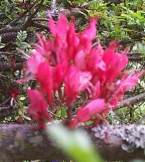Schotia afra var. afra
Schotia afra (L.) Thunb. var. afra
Family: Fabaceae
Common names: Karoo boer-bean (Eng.), Karoohuilboerboon (Afr.)
SA Tree No: 201
Introduction
This delightful, small, water-wise tree is a must for the home gardener who wants an attractive evergreen tree.

Description
Description
Schotia afra var. afra is small in stature (max. height 5 m), evergreen, with rigid branches and a gnarled trunk. The flowers are numerous, bright red to pink in colour, and are borne in small clusters during the months of February and March. They are distributed throughout the tree. The tree is not messy and does not have a destructive root system. It is ideal for attracting nectar-seeking birds during the hot, dry, Western Cape summers. The trees look spectacular when in full flower next to the drabness of the surrounding summer vegetation.

Distribution and habitat
Distribution description
The trees often occur along the banks of dry streams and small rivers in the Little Karoo, the drier areas of Eastern Cape and the southern part of Western Cape.
Derivation of name and historical aspects
History
The genus Schotia was named in honour of Richard van der Schot, chief gardener of the Imperial Garden at Schönbrun. The Afrikaans common name boerboon was given to certain indigenous seeds that are edible. The word huil ("cry" in English) is due to the nectar that drips or weeps from the flowers.
Ecology
Ecology
Flowers produce copious amounts of nectar which attract birds, especially the Lesser Double Collared Sunbird and Malachite Sunbird. The butterfly Deudorix antalis breeds in the tree. The flowers are followed by attractive, large, lime green to pink seedpods which turn brown when ripe. The seed is dispersed through an explosive seedpod which, when dry, catapults the seeds great distances from the parent plant. Seeds are produced in May and June of each year. Under normal circumstances the seeds would germinate in moist soil in late spring after the winter rains.

Schotia afra var. afra is in the subfamily Caesalpinioideae. All the members of this subfamily have pinnately compound, alternate leaves. Leaflets are more than three terminally. The stipules are present

Uses
Use
This tree can be used as a shade and ornamental tree. The leaves are browsed by stock. The seeds are edible either green or mature. They can be used as a meal if roasted and ground. The bark, if ground and soaked in water, can be used as tannin. Schotia afra can be pruned to shape and can be grown as a bonsai specimen.
Growing Schotia afra var. afra
Grow

Schotia afra var. afra seed is easy to collect. One has only to look a few metres away from the parent plants to see the masses of flat, light brown seeds lying on top of the soil.
Use flat plastic or wooden seed pans (seed trays). Sow in a semi-shady area (about 40% shade). Seeds should sown in well-drained, loamy soil. The general rule for the sowing depth is the same as the thicknessof the seed (about 3-5mm). Sow the seeds in late spring, September till mid-October. Water well once a day. Make sure the seeds are not crowded in the pan (this should prevent damping off). The seeds will swell with moisture and should germinate within 7 days. The seedlings should be allowed to develop a tap root and be in their third set of leaves before they are transplanted into planting bags. If they are given enough water and are planted in a rich, well-drained soil, they will develop rapidly.
Tips for planting in the home garden: dig a good hole, 1 m wide by 1 m deep. Use plenty of well-rotted compost and good loam soil in the hole. Add a handful of agricultural lime, super phosphate and 2:3:2 to the soil. Mix it all up well. Plant the sapling. Water well once a week, especially if conditions are dry. Stake the tree to stop wind damage. Under ideal conditions you should be able to sit under the tree within five years.
Watch for aphids/greenfly attacking the new foliage, especially in spring. Spray with a recommended approved aphicide at least once a week for three weeks to break the insects' life cycles, or use environmentally friendly Sunlight liquid soap; about 10 ml in 5 litres water will suffice. Spray liberally on affected parts.
References
- Germishuizen, G., Meyer, N.L., Steenkamp, Y. & Keith, M. (eds) 2006. A Checklist of South African plants. Southern African Botanical Diversity Network Report No. 41. SABONET, Pretoria.
- VAN WYK, B. & VAN WYK, P. 1997. Field guide to trees of southern Africa. Struik, Cape Town.
- DE WINTER, B., DE WINTER, M. & KILLICK, D.J.B. 1966. Sixty-six Transvaal trees. Government Printers, Pretoria.
Credits
Ian Oliver
Karoo Desert NBG
March 2003
Plant Attributes:
Plant Type: Shrub, Tree
SA Distribution: Eastern Cape, Western Cape
Soil type: Sandy, Loam
Flowering season: Late Summer, Autumn
PH: Acid, Neutral
Flower colour: Red, Pink
Aspect: Full Sun
Gardening skill: Easy
Special Features:
Horticultural zones











Rate this article
Article well written and informative
Rate this plant
Is this an interesting plant?
Login to add your Comment
Back to topNot registered yet? Click here to register.